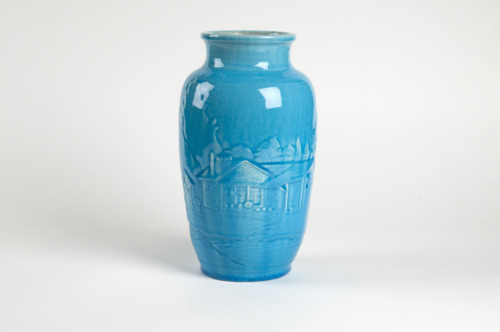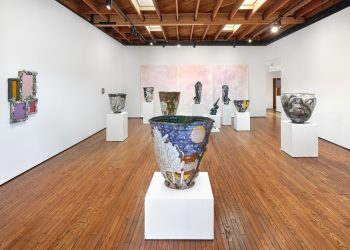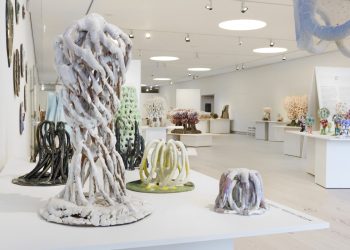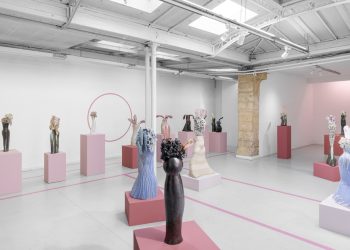
Pisgah Forest and Nonconnah: The Potteries of Walter B. Stephen / University of South Carolina McKissick Museum, Columbia, SC, USA
May 26 – July 27, 2012
Some of the most imaginative and beautiful ceramics of the 20th century will be on display in an exhibition of Walter B. Stephen’s pottery May 26 – July 27 at the University of South Carolina’s McKissick Museum.
Titled “Pisgah Forest and Nonconnah: The Potteries of Walter B. Stephen,” the exhibition will feature 76 rare examples of Stephen’s works, from the first pots that he fired near Nonconnah Creek in Tennessee to crystalline vessels produced at Pisgah Forest near Asheville.
Stephen, born in 1876 in Clinton, Iowa, was heavily influenced by his mother, but he soon began exploring and developing his own creative talents. In 1904, he established the Nonconnah Pottery in Tennessee, where he and his mother produced “paste on paste” cameo wares similar to Wedgwood’s Jasperwares. In 1913, he moved to the Asheville area, where he produced a variety of pottery until his death in1961.
The early Nonconnah pieces are dominated by matte-green glazes with floral designs. The later works made at the Pisgah Forest Pottery range from small, brightly glazed teapots and cups to monumental baptismal fonts. Cameo depictions of the American West include covered wagons, Indians hunting Buffalo and portraits of Bill Cody. Stephen also used imagery of the South such as mountain cabins, fiddlers and Gen. Robert E. Lee. His forms and glazes, particularly the crystalline glaze, were inspired by Asian ceramics.
Two events are planned in connection with the exhibition:
On June 21, from 5:30-7:30 p.m. the museum will host a reception, a gallery talk and a book signing featuring Rodney Leftwich, author of “Pisgah Forest and Nonconnah: The Potteries of Walter B. Stephen.”
From 10 a.m. – 4 p.m. Friday, June 22, McKissick will host a symposium, “The Art of Collecting Southern Pottery.” Leftwich, Karen Swager of Brunk Auctions, crystalline potter Frank Neef, Winton Eugene and Rosa Eugene of Pottery by Eugene, and Barbara S. Perry, who writes about American ceramics, will participate.
The symposium is $40 for museum members and $50 for non-members.
Museum Hours: Monday-Friday: 8:30 am – 5 pm. Saturday: 11 am – 3 pm. Closed Sundays and all University and State holidays.
Open to the public free of charge.
McKissick Museum is located at the heart of the historic Horseshoe on the Columbia campus of the University of South Carolina. It was established in 1976 by the University Board of Trustees to bring together under one roof the many object collections housed in various departments and colleges across campus. These collections date to 1801 and provide insight into the long and illustrious history of the University.
Exhibitions can be found on three floors of the Museum. Permanent installations include the first floor Baruch Silver Gallery, and the third floor exhibition, Natural Curiosity: The University of South Carolina and the Evolution of Scientific Inquiry in the Natural World. Two galleries on the second floor, as well as one on the third, feature changing exhibitions. Additionally, McKissick offers a wide variety of events and programs year-round.
/ Read the interview with Jill Beute Koverman, Chief Curator of Collections and Research of The McKissick Museum (Walter B. Stephen’s work), May 2012 – Vasi Hîrdo.
CONTACT
Frenche Brewer
Broadcast Coordinator and News Writer
brewer4@mailbox.sc.edu
Tel. (803) 777-7251
University of South Carolina McKissick Museum
Second Floor
1300 Wheat Street
Columbia, SC 29208
United States
www.cas.sc.edu/mcks
Above: Walter B. Stephen, Pisgah Forest tall stoneware vase with carved decoration and turquoise blue crackle glaze, 1936. Courtesy McKissick Museum, University of South Carolina.





















